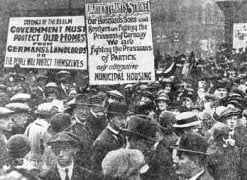The problem
New Labour’s record on housing policy is a
disgrace. Here’s the indictment drawn up by the National Housing
Federation, the outfit that represents housing associations. They say
we face a ‘housing time bomb,’ an ‘explosion of housing need.’ There
are 1.6 million on council house waiting lists. Their numbers are
growing by 7.6% a year. Repossessions were up by 65% last year to
17,000 losing their homes, and official homelessness went up by 14.4%
between 2000 and 2005.
All this is happening because we are not
building enough houses. Last year we built less than any year since the
1920s. And because so few new homes are being built, prices go up so as
to be completely unaffordable for the poorer in our society. New Labour
has left housing provision to the market, and the market has failed to
provide enough. We need a crash house-building programme, and that
requires government action.
A history of house provision
Housing
provision has always been a political issue. The working class has
always had to involve itself in struggle for decent affordable housing
for all. It still must.
 At the beginning of the last century,
At the beginning of the last century,
nearly all workers lived in private rented accommodation. Many of these
were slums. Local councils did have the power to build houses, but
before the First World War many working men (and all women) lacked the
vote. So there were relatively few Labour controlled councils with the
mind to build houses.
The War caused a rush of workers into
industrial areas such as Clydeside to work in the munitions factories.
This gave the slum landlords the chance they needed to jack up rents.
In 1915 working women in Glasgow, backed by the trade unions, went on
rent strike. Munitions workers had a strong bargaining position, and
the government was forced to decree a rent freeze.
Therefore what
capitalist would build new houses to rent, if they couldn’t make money
out of them? But between the Wars four million houses were built. Many
were built in the suburbs for sale. Great numbers of middle class
people and the upper sections of the working class were now able to own
their own houses for the first time.
At the same time Labour’s vote
was rising steadily at the expense of the Liberals, and more and more
councils went Labour. And those councils built more than a million
council houses interwar, good quality homes available at rents working
class families could afford.
Council house blues
Councils were not hamstrung for
cash in the interwar period, even though the Tories were in power
nationally for most of the time. For instance, the London County
Council fell to Labour and its leader Herbert Morrison had Hackney
marshes drained and the reclaimed land used for housing the working
class, in part using government grants.
The blitz in the Second
World War devastated the housing stock. The situation was made worse by
the conscription of virtually all potential building workers. The end
of War saw a terrible shortage of homes, with working class families
forced to squat in disused aerodromes and army and prisoner of war
camps. Aneurin Bevan was Minister for Housing as well as Health in the
post-War Labour government. In addition to setting up the National
Health Service, he insisted on building world-class council houses (I
was brought up in one). The quality of these homes with huge gardens
front and back meant that nobody living in one need regard themselves
as second class citizen. No council tenant need aspire to owning their
own house as long as their tenancy was secure and their rent modest.
But
for years after the War, the housing situation was dominated by chronic
shortage. Tens of thousands lived in prefabs and other temporary
accommodation. The inner city slums still had to be cleared. The
temptation was on councils to cut corners. As the proportion of the
population in council housing went up to 40% in the 1960s, some
councils were flinging up bleak blocks of flats on soulless estates
that soon became a new generation of slums.
 In 1979 Margaret
In 1979 Margaret
Thatcher changed the nature of housing provision forever, as she hoped.
She allowed council tenants to buy their own council houses at
discounts of up to 75%. Longstanding tenants found they could pay less
on a mortgage to buy their house than to pay the rent the council
charged. Of course if they continued as tenants they would be paying
till the end of their days, while if they bought they would be sitting
on a nice little appreciating asset. For some it was a no-brainer.
For
others the options were different. Thatcher didn’t just introduce the
‘right to buy.’ Her government presided over mass unemployment, which
quickly went over three million. The unemployed and those on benefits
couldn’t buy their place, and for those stuck on the estates of flats
thrown up in the 1960s, nobody would really want to buy their flat on
the open market. Many council properties quickly became sink estates
occupied overwhelmingly by people on benefits. Despite the best efforts
of the tenants to keep up standards, some became no-go areas after dark.
That
seemed to spell doom for council house building. What was the point of
spending £45,000 to build a house, if a twenty-year council tenant
moved in and could buy it for half that sum? A year later the local
Labour councillor would see the property on the market tarted up and
going for £80,000. (This is anecdotal evidence from an Ealing
councillor in the 1980s.)
How had council housing usually paid for
itself? The council had to pay up front for the house. After about four
or five years of getting in rents, the council would have broken even.
So new house building was subsidised by existing tenants. But hundreds
of thousands of former council tenants weren’t paying rent any more. In
effect those who exercised the right to buy were running off with
public funds, and they were also shrinking the pool of available social
housing.
Thatcher didn’t make it any easier for Labour
councils. She launched a series of cuts in state subsidies to local
authorities. Then she just banned them from spending money on things
the Tories didn’t approve of. Nobody is building council houses any
more, and we have lost 3.5 million houses since 1979, most because of
the ‘right to buy.’
Fightback
Government policy has been a continuation of Thatcher’s, and
it’s a disaster for the poor. Instead of letting local councils borrow
on the same terms as housing associations, they have kept the
restrictions imposed by Thatcher on what local authorities can do.
Councils can still not borrow to build houses. Instead of letting them
keep rent receipts to maintain the existing stock and build new houses,
the Treasury has grabbed £2 billion a year from local councils, three
quarters of the money. In May 2007 Yvette Cooper announced that
councils could now keep the receipts from council house sales – ten
years too late!
Council house provision here continues to
decay, partly as a result of government policy. The government is
offering a poisoned choice of options to council tenants. They are
encouraging housing associations to take over the estates. Housing
associations do not build houses, they just manage the estates as
landlords. Or tenants can come under the control of an Arms’ Length
Management Organisation (ALMO), or have a Private Finance Initiative
consortium to do up the housing stock. This may sound like an alphabet
soup of organisations. These hybrids all have one thing in common. They
are in business to make money out of social housing. One way they do
this is by gentrifying the properties so the people most in need can no
longer afford to live there. Where are these people supposed to go? The
PFI brigade will be given away swathes of land, some of which they will
use to build profitable (non-affordable) housing.
Labour Party
conference has opposed this attempted destruction of council housing.
They want an end to the rigged ballots, where tenants are in effect
blackmailed to either vote for improvements by going private or
continuing to decay as a council-run estate. Along with the Defend
Council Housing campaign, tenants want a fourth option – for council
housing to be kept and be given a level playing field – the same
resources as New Labour would throw away on an ALMO or the PFI crooks.
Incredibly in 224 out of 360 ballots, tenants have rejected
privatisation and affirmed their belief in the principle of council
housing. They are right. Our council housing stock is a £400 billion
asset for the nation built up over generations that should be conserved
and improved, not something to be stolen.
Private housing out of reach
So more and more people are forced on to the private housing
market to get a roof over their head. But the 1.6 million on council
house waiting lists show this is not an option for everyone. Home
ownership is often presented as a natural result of increasing
prosperity or an exercise of ‘choice.’ It is nothing of the sort.
Statistics show that the countries with the highest proportion of
homeowners are India and Thailand. But their homes are, in many cases,
hovels. In Germany and Sweden the quality of the housing stock is on
average higher than in Britain. There, so long as they have security of
tenure, more workers have the option to rent than in Britain, and they
are happy to do that.
 Now a big majority of households go for
Now a big majority of households go for
owning their own house, not because we’ve become a ‘property owning
democracy,’ but because they have no choice. Soon four in five will own
their own house, or rather the mortgage on it. At present the average
price of a house is £180,000, six times average earnings. In the past
banks have gone by a rule of thumb that the maximum repayments anyone
could afford was five times earnings. Now they just throw money at
borrowers, blowing up the house price bubble. And repayments are edging
up as the Bank of England pushes up interest rates. Hence the rise in
repossessions and homelessness.
For workers on less than average
earnings, it is proving impossible to get a foot on the bottom rung of
the property ladder. Many people are completely dependent on family
financial support to get a roof over their head Yvette Cooper has
warned that 70% of young couples will be unable to afford a home. So
what is she doing about it?
House prices are often described as
a ladder. We’ve all met people who’ve done very well out of rising
house prices. But really the whole thing is more like a roundabout. You
only benefit if you can get off at the right time. Property prices have
tripled in the past ten years. But how does that benefit you if you’re
sitting in the same bricks and mortar? If you need to move house, it’s
probably going to cost you three times as much to move as it would have
ten years ago. Overall it’s a zero sum game, with as many losers as
winners.
There is no doubt that the present rise in house prices
is a bubble. The definition of a bubble is when prices go up because
people are buying, and people are buying because prices are going up.
Nobody can predict when the bubble will burst, but that is what bubbles
usually do. Then you get a situation where prices are going down
because people are selling, and people are selling because prices are
going down. The last time the house price bubble burst was in the
1990s. Millions were left with ‘negative equity’. They were stuck in a
house that was worth less than when they took out the mortgage, so they
couldn’t move and couldn’t really afford to stay.
Conventional
economic theory, always an apologist for capitalism, says this
shouldn’t happen. When rising demand causes the price of a commodity to
rise, capitalists will up the supply and all will be well. But builders
are not building more houses. Clearly, in relation to housing need,
capitalism is not delivering the goods.
The way forward
What is the government doing about all this? Mainly they are
supinely waiting on the market, though it is clear we could wait
forever. What we need is massively more affordable social housing. It
is clear that housing must be built in a planned manner on the order of
the public sector. It must be publicly owned and affordable, and there
can be no question of tenants being allowed to walk away with a public
resource.
Ask the building companies what the problem is and
they say it is planning restrictions. They are slavering to carve up
the green belt. Rubbish. Most of them are sitting on portfolios of
development land as a speculative investment. What we want is houses
near our jobs. There are not many jobs on the green belt. Our main
immediate strategy must be to build to regenerate the inner cities and
end urban blight, by building first on brownfield sites.
We
want council’s powers to be restored for the sake of local democracy.
What’s the point in voting for councillors if they can’t decide
anything? But we face a national housing crisis. That needs national
action.
 We have over 200,000 homeless (and how do you count
We have over 200,000 homeless (and how do you count
rough sleepers?). Meanwhile the rich have a quarter of a million second
homes, most only used at weekends. These are often located in
picturesque but low paying parts of the country. The rush for second
homes creates ghost villages and drives property prices completely
beyond the reach of the locals. We can and should tax second homes more
than the ones people actually live in. But the problem will only really
be dealt with by creating a more equal society where everybody can
afford a roof over their head and nobody can flaunt their wealth at the
rest of us.
The big building companies have failed. They must
be taken over. The construction industry is a jungle. Half a dozen big
firms dominate the industry – Wimpey, Balfour Beatty, Bovis, Persimmon
and the rest of them. They dictate what to do to a cat’s cradle of
sub-contractors. At the bottom of the pile are thousands of little
firms consisting of little more than two men and a ladder, and
so-called self-employed workers on the lump. As a result of this chaos,
construction has one of the worst safety records of any industry Take
over the big boys and we can plan and run the whole show.
We
need to own the land as well. What we need is a National Housing
Corporation to make an inventory of the land and materials at our
disposal and draw up a strategy for a mass programme of house building.
One
of the problems of Prescott’s plan for housing in the Thames gateway is
that there is little provision for affordable housing. Secondly it is
basically a matter of dumping a load of private housing estates down
without planning for jobs or social amenities to go with them, and in
some cases with inadequate infrastructure. Housing provision must be
part of an overall socialist plan.






